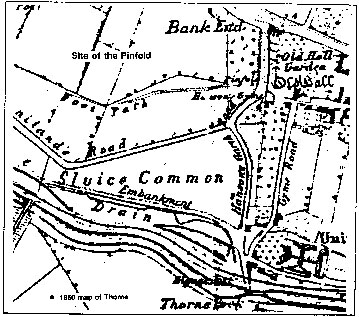The information presented is there to be used and enjoyed but please be sure to
acknowledge the source and author if you use any material.
Snippets of Yesteryear
Thorne's Pinder and Pinfold

The last pinfold to be used in Thorne was situated opposite the old Thorne Hall (Pinfold Lane), behind the flood bank at Bank End in a field known as Lees Orchard (see map). Part of the field is now the site of the Ambulance Station on Selby Road. The pinfold was at the other end nearer to Whites Lane. Access to the pound was through a gap cut into the flood bank. A gate with stone gate posts was at the entry with a fenced off area for the impounded animals.
The pinfold was run by the parish overseers and the pinder was elected every year by the parishioners. A notice would be posted for a parish. meeting in the church vestry or in the `long room'. It was an open meeting with the folk of the town taking an active part in the proceedings.
A ’pinder’ – one who catches stray animals
and puts them into an enclosed pound or ‘pinfold’.
ELECTED OFFICERS
In 1724, John Simpson was elected as pinder. Other overseers and officers were: Constables - John Lennard and John Brook; Ale Taster (checking watered and weak beer) – John Yates; Swine Ringer (putting rings through pigs' nose, to stop them rooting and damaging crops); Field Graves (encroachment on ground used for crops) - Joe Atkinson, W Smith, Tom Lowe and Robert Waite; Haddes Graves - Ralph Wilson and John Carter. In 1757 the Pinder elected was James Thicket.
VERGE GRAZING
In the active days of the pinfold one means to help the parish coffers was to rent the grazing or mowing of the grass verges - in 1820 a total of 19 lane and roadsides were up for rent – they were divided into 30 gates or lots at a cost of 20/- each. Preference was given to `labouring men' to keep a horse or cow on the verge provided they keep them continually tethered by the head. No cattle shall be allowed to be in the lanes before sunrise or after sunset.
Any cattle at liberty or straying would be impounded in the pinfold. For the first offence the owner shall pay 1/- (one shilling) each and then shall increase to 10/-each. In 1857 the amount raised for tending cattle was £25.
Records of the pinfold's use are known until 1894. Some years after its disuse and the need for the pinfold gone, the council sold the brick material and stone coping. The stone gateposts were removed to land near the Coulman Recreation ground. The bank was re-instated and the land was used as an orchard, within the memory of some of the older residents of Thorne.


During the Second World War an army tank knocked down and smashed one of the gate posts leaving just one forlorn gatepost now - the only testimony to Thorne's last pinfold.
-- F Dallas
Thanks to Glyn Ambrose for permission to use this information.
© Thorne Moorends Regeneration Partnership. All Rights Reserved.
